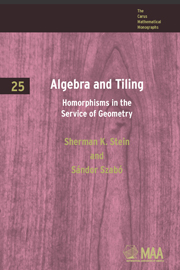Book contents
- Frontmatter
- Preface
- Contents
- Chapter 1 Minkowski's Conjecture
- Chapter 2 Cubical Clusters
- Chapter 3 Tiling by the Semicross and Cross
- Chapter 4 Packing and Covering by the Semicross and Cross
- Chapter 5 Tiling by Triangles of Equal Areas
- Chapter 6 Tiling by Similar Triangles
- Chapter 7 Rédei's Theorem
- Epilog
- Appendix A Lattices
- Appendix B The Character Group and Exact Sequences
- Appendix C Formal Sums
- Appendix D Cyclotomic Polynomials
- Bibliography for Preface
- Supplement to the Bibliography
- Name Index
- Subject Index
- Symbol Index
Chapter 1 - Minkowski's Conjecture
- Frontmatter
- Preface
- Contents
- Chapter 1 Minkowski's Conjecture
- Chapter 2 Cubical Clusters
- Chapter 3 Tiling by the Semicross and Cross
- Chapter 4 Packing and Covering by the Semicross and Cross
- Chapter 5 Tiling by Triangles of Equal Areas
- Chapter 6 Tiling by Similar Triangles
- Chapter 7 Rédei's Theorem
- Epilog
- Appendix A Lattices
- Appendix B The Character Group and Exact Sequences
- Appendix C Formal Sums
- Appendix D Cyclotomic Polynomials
- Bibliography for Preface
- Supplement to the Bibliography
- Name Index
- Subject Index
- Symbol Index
Summary
The origins of most of the tiling problems we will explore go back just a short time. But Minkowski's problem, like many ideas in mathematics, can trace its roots to the Pythagorean theorem, a2 + b2 = c2. We shall trace these roots, and then go on to describe some of the problems that Minkowski's question, in turn, suggested. We do this in order to place the problem in its proper position in the intricate web that constitutes mathematics.
1. Introduction
The Greeks discovered all integer solutions of the equation x2 + y2 = z2: pick three integers d, m, and n, and let one of x and y be d(2mn) and the other be d(m2 − n2), and z = d(m2 + n2). Inspired by this, Diophantos, who lived some time between A.D. 150 and A.D. 350, described techniques for producing rational solutions of such equations as x2 + y2 = z3, x3 + y3 = z2, and x4 + y4 = z3. He does not refer to the equation x3 + y3 = z3, whose first recorded mention is in a letter written about the year A.D. 1000 by the mathematician Abu Djafar Mohammed Ben Alhocain [22]:
I have already explained that the arguments that Abu Mohammed Alkhodjandi, may God have mercy on him, has proposed in this demonstration that on the addition of two cube numbers there does not result a cube, are defective and inexact.
- Type
- Chapter
- Information
- Algebra and TilingHomomorphisms in the Service of Geometry, pp. 1 - 34Publisher: Mathematical Association of AmericaPrint publication year: 2009



